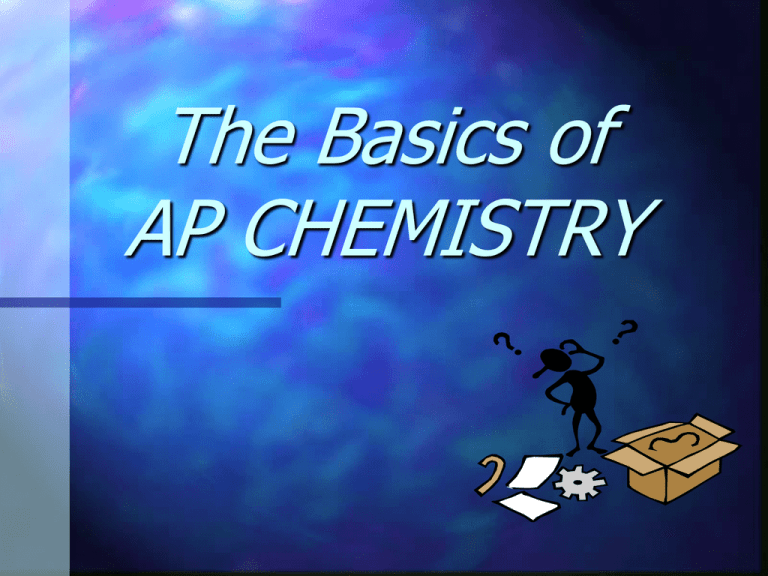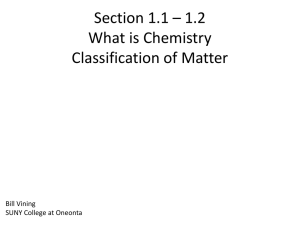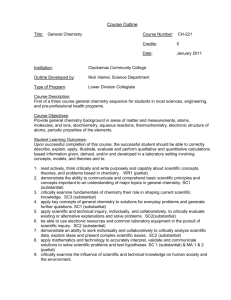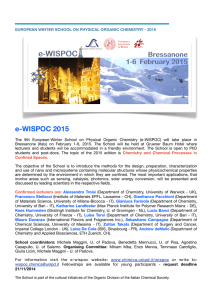AP Basics
advertisement

The Basics of AP CHEMISTRY This is a PowerPoint that is designed for people who have skipped a year in between Chemistry and AP Chemistry and do not remember a single thing that they learned. OVERVIEW The History of Chemistry The Scientific Method Laws and Theories Units of Measurement Weight/Mass Correct way to Measure Significant Figures Rounding Precision/Accuracy Density Matter Mixtures Physical/Chemical Changes Compound/Element Important Laws Dalton’s Atomic Theory Atomic Weight/Mass Electrons Radioactivity Atoms Protons/Neutrons Isotopes Bonding The Periodic Table Acids/Bases What is Chemistry? According to the internet (dictionary.com), chemistry is the science of the composition, structure, properties, and reactions of matter, especially of atomic and molecular systems. Historic Chemistry The Greeks were the first to use Chemistry to try to explain why chemical changes occur. – Demokitos, Leucippos Historic Chemistry Continued There was also a time period where alchemy took over chemistry (this was about 2000 years). They discovered several elements and were able to prepare mineral acids. Historic Chemistry Continued Modern Chemistry ~ 16th century – Bauer ~ systematic metallurgy – Paracelsus ~ medicinal chemistry Historic Chemistry Continued The first real chemist to actually perform experiments that gave him quantitative results was Boyle. We all know him for the law that he founded…Boyle’s Law. – This law states the relationship between pressure and the volume of air. Historic Chemistry Continued Oxygen was first observed by Scheele/Priestley. Stahl studied combustion and learned of all its properties and exactly how it works. Oxygen was originally called dephlogisticated air The Scientific Method This method was developed in order for scientists to have guidelines for solving problems. The steps of the scientific method include making observations, formulating a hypothesis, and performing experiments to get results and make conclusions. A theory… A theory is also known as a model. A theory is specifically a hypothesis that has been tested to such an extent that the explanation for the outcome of the experiment remains constant. A Natural Law This is a summary of the observed behavior that has been taking place. A law summarizes what has happened and what should happen if a similar experiment were to be performed. Units of Measurement There are 7 basic SI (International System) units that are needed: – Mass - kilogram (kg) – Length - meter (m) – Time - second (s) – Temperature - kelvin (K) – Electric Current - ampere (A) – Amount of Substance - mole (mol) – Luminous Intensity - candela (cd) Units of Measurement P R E F IX E xa There are also prefixes that are used in the SI system. P eta T era G ig a M eg a K ilo H ecto D eka D eci C en ti M illi M icro N an o P ico Fem to A tto Continued E X P O N T E N T IA L N O T AT IO N 18 10 15 10 12 10 9 10 6 10 3 10 2 10 1 10 0 10 -1 10 -2 10 -3 10 -6 10 -9 10 -1 2 10 -1 5 10 -1 8 10 IMPORTANT INFORMATION Something that is important to remember when taking AP Chemistry: – 1 liter = (1 dm)3 = (10 cm)3 = 1000 cm3 – 1 liter = 1000 cm3 = 1000 mL Weight vs. Mass Mass is a measure of the resistance of an object to change in its state of motion. Weight is the response of mass to gravity. Weight vs. Mass YOU CANNOT USE MASS AND WEIGHT INTERCHANGABLY. We are correctly supposed to use the term weight because we are comparing the object’s mass to the standard mass, however, mass is used consistently in all types of scientific equations. The CORRECT Way to Measure When measuring a volume or the length of an object, it is necessary to record all of the numbers that are known and then estimate the last place value when not using a measuring device that measures the object’s exactly. This should be done consistently, accurately, and precisely. Significant Figures Significant figures are always used in scientific calculations. They can be very confusing, but once they are understood, they are a piece of cake. Significant Figures Continued When recording data, all the known values are recorded and the last digit is an estimated value. Significant Figure Rules Nonzero integers always count as significant figures. Leading zeros do not count. They just show the position of the decimal point. – Example: 0.00065 There are only two significant figures in this number. The zeros that precede the 65 do not count. Significant Figure Rules Any zero that is in between two nonzero numbers always counts – Example: 6.00045 There are six significant figures in this number. Zeros like these always count as significant figures. Zeros that are found at the end of numbers never count. – Example: 4.7800 There are only three significant figures in this number. The two zeros at the end do not count. Significant Figure Rules A final rule to abide by is the exact number rule. Exact numbers cannot be changed and are assumed to have an infinite number of significant figures. – Example: We performed 5 experiments The five experiments cannot be changed in any way. – Example: 1 liter = 1000 mL This is also an exact number and cannot be changed. Mathematical Operations Involving Significant Figures When multiplying or dividing numbers, the number of significant figures needs to be taken into account. The answer needs to have the same amount of significant figures as the number with the least amount of figures. – Example: 5.677 * 3.4 = 19 3.4 only has two significant figures and therefore the answer can only have two significant figures Mathematical Operations Involving Significant Figures When adding and subtracting numbers you would go by the number of decimal places that the number has. The number with the least amount is the one that you use as your reference in the answer. – Example: 4.0089 + 2.4 = 6.4 Rounding Rules In case you forgot how to round properly, you can simply follow these directions – ALWAYS carry digits through until the final answer. Then you can round. – When rounding numbers, if a number after the number that you are stopping at is at 5 or above, round up. If it is less, then keep the number as it is. Review of Previous Slides Now, if you wanted to round this number to three significant figures…what would it look like? 4.06789 The number would be 4.07 rounded to three significant figures. Precision vs. Accuracy Precision is the degree of agreement of several measurements to original value. Accuracy is the degree of agreement of a single measurement in comparison to the original value. DENSITY Density is the mass of a substance per unit Volume of the substance. – Formula for density is as follows: Density = mass/volume Any density can be determined when these two items are known. What is Matter? Anything occupying space and having mass. The four different states of matter include: solid liquid gas plasma Mixtures Mixtures are pure substances that are composed of more than one thing. – Homogenous mixture (solutions) indistinguishable parts Example: air – Heterogeneous mixture - distinguishable parts Example: Sand in Water Mixtures Pure Substances – These are substances that have a constant composition An example of this would be water Physical Changes This is a change that is characterized by the fact that the substance does not change in composition, rather it just changes in shape and form – An example of a physical change is a substance that changes from boiling to freezing. It has not changed in composition, just the way that it looks. Chemical Changes Chemical changes are characterized by the fact that the substance would change in composition and technically become something else. – An example of a chemical change would be a metal that has rusted. The chemical composition of the metal would no longer be the same. Separating Mixtures There are many different ways to separate mixtures. – Distillation (mixtures are heated and the components of the mixture separate) – Filtration (the liquid passes through a filter and separates) – Chromatography (components have different affinities for the two phases (stationary and mobile) causing them to move at different speeds Compound vs. Element A compound is a substance with constant composition that can be broken down into elements by the use of chemical processes. An element is a substance that cannot be broken down any further by any type of chemical or physical means. A VERY Important Law The Law of the Conservation of Mass – This law states that mass is never created nor destroyed, it is conserved through chemical and physical changes of any kind. This is the basis of all of chemistry! Another VERY Important Law Proust’s Law, or the Law of Definite Proportions states that a compound always has a constant composition. It contains exactly the same proportion of elements by mass, as Proust put it. Yet Another VERY Important Law THE LAW OF MULTIPLE PROPORITONS: – States that when two elements form a series of compounds, the ratios of the masses of the second element that combine with 1 gram of the first element can always be reduced to small whole numbers. Dalton’s Atomic Theory There are four parts to Dalton’s Theory: – Every element is made up of tiny particles called atoms. – All atoms of a single element are identical. The atoms of different elements are different in one way or another. – To form a chemical compound, atoms of unalike elements need to be combined. – Chemical reactions result in the moving around of atoms (changes in the way that the atoms bond). Atomic Mass/Weight Dalton was the first to come up with a table that showed the atomic masses of elements that were known. This was later proved to be incorrect. Atomic Mass/Weight Continued Gay-Lussac and Avogadro were the first to use special formulas that are now used in order to find the formulas for compounds. Avogadro took this further and made a hypothesis that says: – At the same temperature and pressure, equal volumes of different gases contain the same number of particles. J.J. Thomson and the Electron J.J. Thomson used cathode ray tubes and found that the ray in middle of the tube was really a stream of negatively charged particles that are now called electrons. He also determined the charge to mass ration of the electron: – e/m = -1.76 x 108 C/g He also assumed that all atoms must have electrons, however, atoms are overall neutrally charged, therefore he assumed that there must be positive charge somewhere! Plum Pudding? Plum pudding is referred to as the diagram of the proton because there is a cloud and there are raisin like circles floating through it, just like in plum pudding. This was thought to be the original model of the proton. Robert Millikan He, with the help of Thomson, was able to calculate the mass of the electron: 9.11 X 10-31 kilogram THAT IS A VERY SMALL NUMBER!!!! Radioactivity Becquerel was the first to discover radioactivity. Radioactivity is the spontaneous emission of either a gamma, beta, or alpha particles caused this. Nuclear Atom This is an atom with a dense center of positive charge with the electrons moving around the nucleus at a distance that is large relative to he nuclear radius. Protons and Neutrons The nucleus contains both protons and neutrons. – Protons are positively charged atomic partices. – Neutrons are atomic particles that have no charge at all. What is an Isotope? These are a form of the atom that contains the same number of protons, but a completely different number of neutrons. When Elements Come Together There are chemical bonds that hold atoms together. The atoms can form bonds by sharing electrons (covalent bond) and those atoms together are called molecules. A way to represent the coming together of atoms is by a chemical formula, like NaCl. This is the coming together of Sodium and Chlorine. The Na and the Cl are the abbreviations for those specific elements. More Bonding Ionic Bonding is when there is a force of attraction between oppositely charge ions. Ionic bonding terms: – A solid that has an ionic bond ~ ionic solid or a salt. THE PERIODIC TABLE A chart that shows all the elements, as well as the groups/ families and periods, and their descriptions is known as a periodic table. The Periodic Table Continued There are metals and nonmetals. – Metals can conduct electricity and heat. The also usually have lustrous appearance. Example: Copper – Nonmetals usually appear in the upper-right corner of the table. The lack physical properties like the metals. The usually gain electrons in reactions with metals. They like covalent bonding. Example: Chlorine Sections of the Periodic Table All elements that are in the same vertical column (group/family) have similar characteristics (chemically). Alkali Metals – Group 1A – Active elements, have a +1 charge when reacting with nonmetals Sections of the Periodic Table Alkaline Earth Metals – Group 2A – Form ions with a +2 charge when reacting with nonmetals. Halogens – Group 7A – All form diatomic molecules Group 8A (Noble Gases) can exist under normal conditions as monatomic gases and they have little chemical reactivity. Sections of the Periodic Table The horizontal rows of the periodic table are known as periods ACIDS When dissolving a substance in water, certain molecules produce a solution containing free hydrogen ions. These substances are called acids. They do no contain oxygen and have a greater amount of hydrogen ions in comparison to hydroxide ions. BASES The exact opposite is true for bases. These substances, when dissolved in water, tend to have a lot more of hydroxide ions, rather than having hydrogen ions. I hope that this presentation helped all of those that are now taking AP Chemistry and really do not understand anything that they learned in regular or Advanced Chemistry. I know that if I would have had something like this, it would have helped a lot in preparation for the first day of class…Good Luck! THE END









